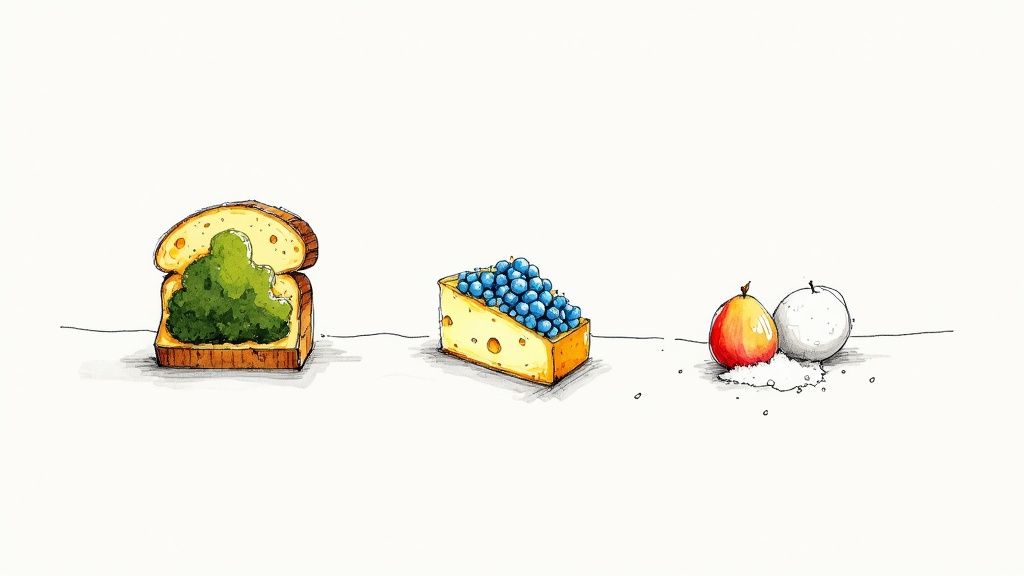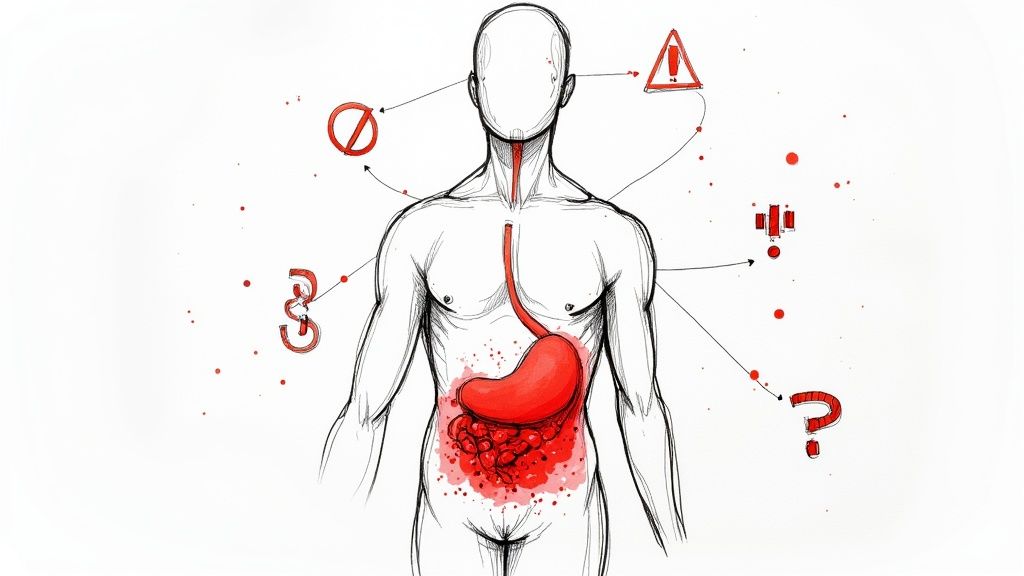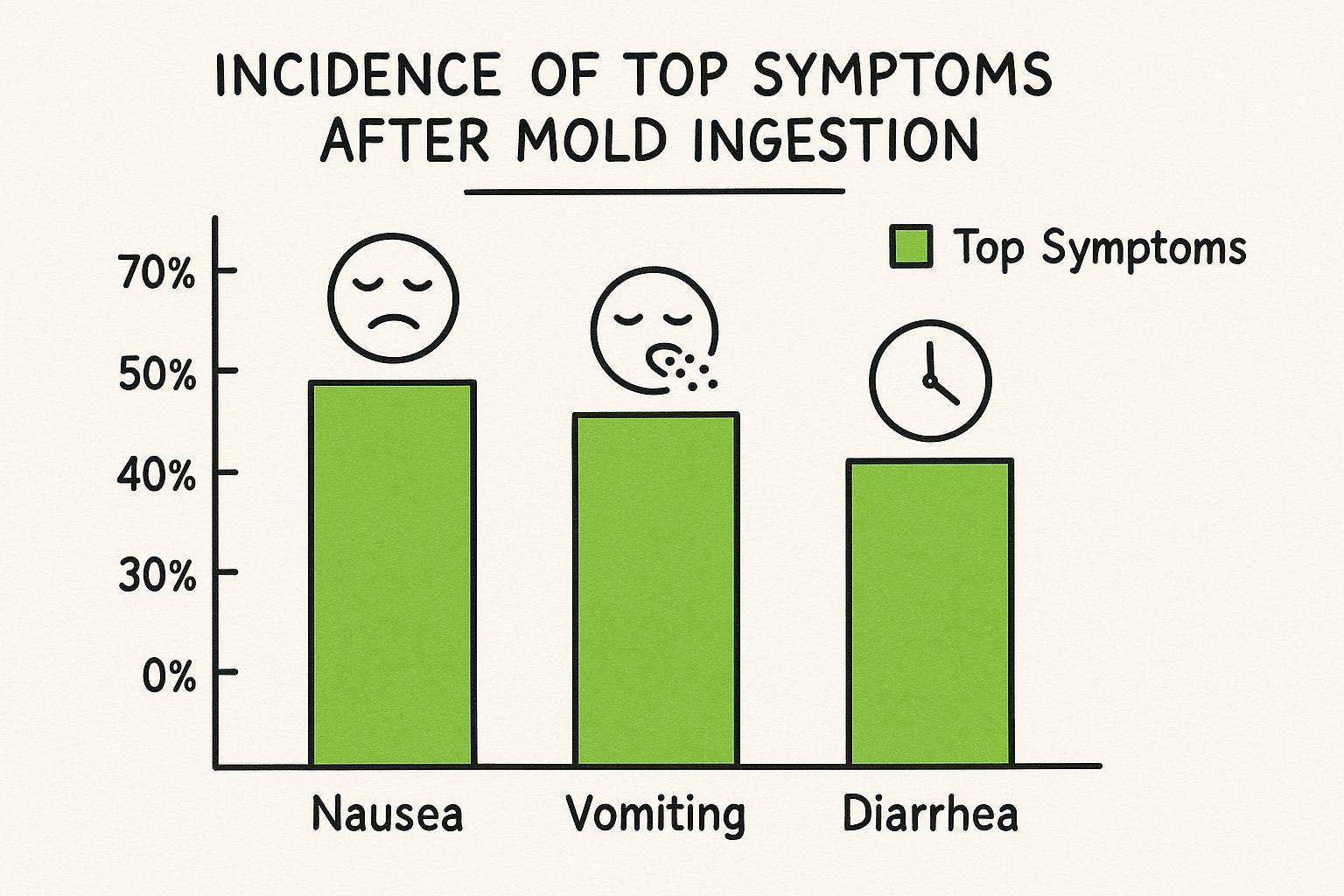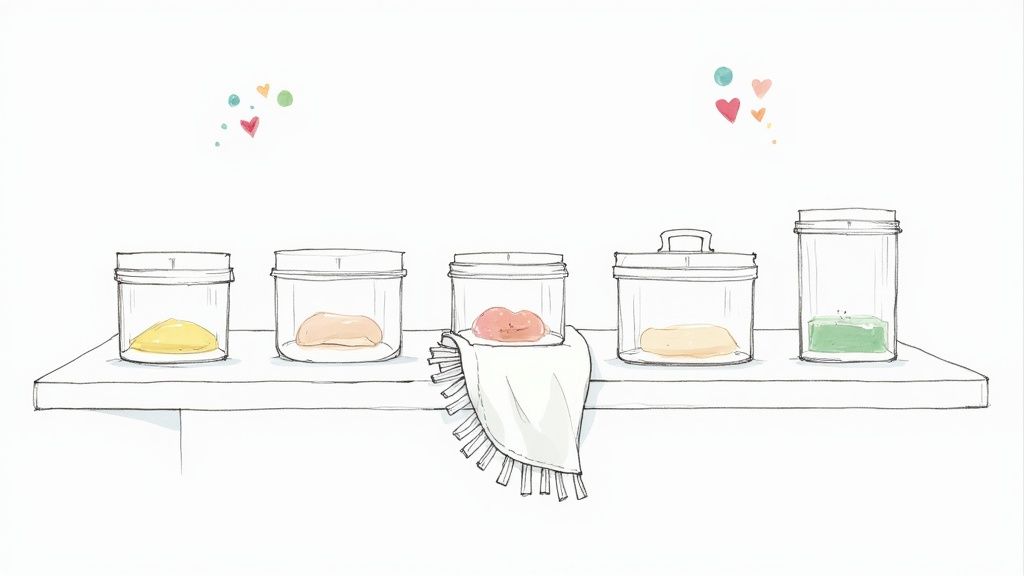It's a moment we've all dreaded: you take a bite of food only to realize it's spotted with mold. The immediate reaction is usually a mix of disgust and panic. But what actually happens if you eat it?
For most healthy people, the answer is refreshingly anticlimactic: usually, nothing at all. Your stomach acid is an incredibly powerful defense mechanism, and it's more than capable of neutralizing most common mold spores before they can cause any real problems.
Your Body’s Built-In Defense System
Think of your digestive system as a robust internal security force. When a small piece of moldy bread or fruit enters the scene, that team springs into action. Your stomach acid is the first line of defense, and it’s potent enough to destroy the vast majority of microorganisms you might swallow, including mold.
This whole process is remarkably efficient. In most cases, your body takes care of the minor intrusion without you ever feeling a single symptom. It's a silent, behind-the-scenes operation that protects you every day.
So Why All the Worry?
The real concern isn't about the mold itself but rather what certain types can produce. While your stomach acid handles the spores, it can't always neutralize the microscopic toxins, called mycotoxins, that some molds create. Even so, a single, accidental bite is highly unlikely to contain enough of these compounds to make a healthy person sick.
The reality is, a minor, one-time exposure to food mold rarely leads to serious health issues. The human body is well-equipped to manage small amounts of common molds, often without any noticeable effects.
While there isn't a global estimate for how many people experience symptoms after eating mold, the consensus is that most exposures cause no issues in healthy individuals. The primary risk is for people with pre-existing mold allergies, asthma, or compromised immune systems. For a deeper dive, the CDC offers detailed insights on mold exposure and health risks.
This should help put the common fear into perspective. It’s not about being reckless with food safety, but about understanding that your body is surprisingly resilient. Of course, the best strategy is always prevention. For tips on keeping your kitchen safe and organized, check out our collection of kitchen guides and recipes.
A Guide to Common Molds on Your Food

It can be a little jarring to open the fridge and find something fuzzy growing on your food. But not all mold is a sign to panic. In fact, some of the best foods we eat, like salami and blue cheese, rely on specific, intentional molds for their unique flavors.
The real trick is knowing which molds are harmless and which are a sign to toss the food out.
Think of a moldy spot like an iceberg. The fuzzy stuff you see on top is just a small part of the picture. Underneath the surface, a vast network of microscopic roots, called hyphae, can spread deep into the food. This invisible invasion is why you can sometimes save a piece of hard cheese but have to throw out an entire loaf of bread.
Why Food Texture and Moisture Matter
The structure of your food is the single most important factor in how far mold can travel. Hard, dense foods are like a brick wall for those tiny mold roots, making it tough for them to penetrate very far.
But for soft, moist foods, it's a different story. They’re more like an open field, letting the hyphae spread out quickly and easily. This means the mold has contaminated areas that still look perfectly normal to the naked eye.
That’s why you can usually salvage a block of cheddar by cutting off the moldy spot, but you should never do the same with a moldy slice of bread. The soft, porous nature of bread allows mold to spread far beyond what you can see. The same goes for high-moisture foods like yogurt, jams, or soft berries, which create the perfect breeding ground for widespread contamination.
Deciding what’s safe can feel like a guessing game. To make it easier, I've put together a simple guide to help you know when to toss something and when it’s okay to keep it.
When to Toss It and When to Keep It
Use this chart as your go-to reference whenever you find mold lurking in your kitchen. It takes the guesswork out of making a safe decision.
| Food Type | What to Do | Why It Matters |
|---|---|---|
| Hard Foods (Hard cheese, firm fruits/veggies like carrots) |
Keep (with caution). Cut off at least 1 inch around and below the mold spot. Be careful to keep the knife out of the mold itself to prevent cross-contamination. | The dense structure makes it hard for mold roots to spread. Removing a generous chunk around the spot gets rid of the affected area completely. |
| Soft Foods (Bread, yogurt, soft cheeses, berries, jams) |
Toss it. Discard the entire item or container right away. Don’t even try to scoop out the moldy part. | The high moisture and porous texture allow invisible mold roots and potential toxins to spread throughout the entire product, even if you can't see them. |
| Meats & Leftovers (Cooked casseroles, cured meats like ham) |
Toss it. Mold on these foods often means there’s spoilage and nasty bacteria growing right alongside it. | These foods are moist and provide an ideal breeding ground for all sorts of harmful microorganisms, making them unsafe to eat. |
Knowing how to handle your food correctly is always the best policy. For example, prepping larger items for big meals requires its own set of rules, which is why our guide on how long to cook a cured ham can be a real lifesaver.
By following these simple guidelines, you can feel confident in your decisions, keeping your household safe while cutting down on food waste.
Understanding the Hidden Risk of Mycotoxins

When you see a fuzzy patch of mold on your bread, your first thought is probably about the mold itself. But the real concern is often something you can't see at all: mycotoxins. These are toxic chemical byproducts that some (not all) types of mold create under the right conditions.
You can think of mycotoxins as a mold’s defense mechanism. The mold isn't trying to harm us; it's just producing these compounds to outcompete other fungi and bacteria for its food source. The problem is, when we accidentally eat that mold, we might be eating these invisible toxins, too.
This is the key to understanding what really happens if you eat mold. It's not just about the spores, but about the potential for ingesting these secondary chemicals that have seeped into the food.
The Real Risk Is Long-Term Exposure
Let's be clear: for a healthy person, accidentally eating a tiny bit of moldy food one time is very unlikely to cause any serious, immediate harm. Our bodies are pretty good at handling small, one-off exposures. The real health risk with mycotoxins isn't about that single, unfortunate bite.
The bigger worry is chronic, long-term exposure. This can happen if you consistently eat foods that have been stored improperly and are prone to mold growth, especially certain staple crops.
What makes mycotoxins so sneaky is that they are invisible and incredibly resilient. They can linger in food even after the visible mold has been removed, and many can even survive the heat of cooking.
This is why food safety agencies around the globe have put strict rules in place. They set firm limits on the amount of dangerous mycotoxins allowed in our food, paying special attention to products that are known to be at higher risk.
These high-risk foods often include:
- Grains and Cereals: Think corn, wheat, and oats.
- Nuts and Legumes: Peanuts and pistachios are common examples.
- Dried Fruits and even some spices.
These regulations are a huge part of why the food you buy at the store is generally safe from dangerous levels of mycotoxins.
Aflatoxins and Other Noteworthy Mycotoxins
While immediate, severe illness from eating mold is rare, some mycotoxins are known to be much more dangerous, even classified as human carcinogens. The most notorious of these are aflatoxins. They can pop up in crops like peanuts and corn and have been directly linked to an increased risk of liver cancer.
Scientists have actually identified between 400 and 500 different mycotoxins, but thankfully, only a handful are considered a serious threat to our health. If you want to dive deeper into the science, the World Health Organization offers some excellent information on these compounds and their effects.
What to Watch For If You Accidentally Ate Mold
So, you took a bite of something and realized it was moldy. It’s an unsettling moment, but for most healthy people, the aftermath is surprisingly uneventful. Often, nothing happens at all.
If your body does react, the symptoms are usually mild and pop up pretty quickly. They generally fall into one of two camps: your stomach gets upset, or you have a minor allergic reaction. Knowing what to look for can help you stay calm and figure out what to do next.
Immediate Digestive and Allergic Reactions
The most common signs that you’ve eaten mold are digestive. Think of it as your body’s rapid response team clearing out an unwelcome guest. Your gut might go into overdrive to expel the mold, leading to some discomfort that thankfully doesn't last long.
The other possibility is an allergic reaction, which is more likely if you're already sensitive to airborne mold. This is just your immune system sounding the alarm and overreacting to the mold spores as if they were a major threat.
Here are the most common things you might feel right away:
- Nausea and Stomach Cramps: This is often the first sign that your digestive system is not happy.
- Vomiting or Diarrhea: Your body’s most direct way of saying, "Get this out of me now!"
- Allergy Symptoms: This can look like a classic hay fever attack—itchy eyes, a runny nose, sneezing, or even a skin rash like hives.
These symptoms usually show up within a few hours and tend to clear up on their own as your body handles the situation.
This image highlights the most frequently reported digestive symptoms people experience after eating mold.

As you can see, nausea is the top complaint by a long shot. This really underscores that a bit of stomach upset is the most likely outcome for most people.
Are There Long-Term Health Concerns?
While immediate symptoms are far more common, the conversation about eating mold often turns to mycotoxins and their potential long-term effects. It’s crucial to understand that these serious issues are tied to chronic, repeated exposure—not a single, accidental bite of moldy bread.
Regularly eating foods contaminated with high levels of mycotoxin-producing molds, like aflatoxins in poorly stored nuts and grains, is what can lead to significant health problems down the road. This isn’t about an acute, one-time reaction; it’s the result of a buildup over a long period.
The difference is key: an upset stomach today is a short-term, acute reaction. The risk of things like liver or kidney damage comes from long-term, repeated exposure to high levels of mycotoxins, which is incredibly rare in a typical diet.
To make this distinction crystal clear, here’s a quick comparison of what to expect right away versus the potential for long-term problems.
Immediate Reactions vs. Long-Term Concerns
| Symptom Category | Typical Onset | Common Symptoms | Primary Cause |
|---|---|---|---|
| Immediate Reactions | Within a few hours | Nausea, vomiting, diarrhea, skin rash, itchy eyes | Your body's response to mold spores or mild toxins |
| Long-Term Concerns | Over months or years | Liver damage, kidney issues, weakened immune system | Chronic exposure to specific mycotoxins like aflatoxins |
Ultimately, a one-off incident with a small amount of mold is highly unlikely to cause any lasting harm. Just keep an eye out for any immediate symptoms, and rest assured that your body is well-equipped to handle a minor mishap like this.
Who Is Most Vulnerable to Mold?
For most healthy people, accidentally swallowing a bit of moldy bread isn't a big deal. Your body's defenses are pretty good at handling minor invaders. But that's not the full story for everyone. What happens when you eat mold really depends on the person.
Think of your immune system like a well-trained security guard. In a healthy person, that guard easily handles a small disturbance and moves on. For others, though, that guard might be overworked, underequipped, or already busy dealing with other problems. This is why certain groups of people are far more likely to get sick after eating mold.
People with weakened immune systems are at the top of that list. Their bodies just don't have the resources to fight off foreign trespassers like mold spores.
People with Compromised Immune Systems
This is a broad category that includes anyone whose natural defenses are down. For them, a mold spore that a healthy person would eliminate without even noticing could spiral into a much more serious infection.
This group includes people like:
- Those undergoing chemotherapy: Cancer treatments are designed to be tough on cancer cells, but they often suppress the immune system as a side effect, leaving patients very vulnerable.
- People with HIV/AIDS: This virus directly attacks the immune system, crippling the body's ability to fend off all kinds of infections.
- Organ transplant recipients: To prevent their bodies from rejecting a new organ, these patients take powerful immunosuppressant drugs. A necessary trade-off is that these drugs also lower their defenses against things like mold.
For these folks, eating mold can quickly escalate from a minor "oops" to a major health threat, potentially causing serious fungal infections that can spread throughout the body.
It’s not that the mold itself is suddenly more dangerous. It's that the body's ability to deal with it is critically low. A tiny spark can turn into a blaze when there's no firefighter around to stomp it out.
Those with Pre-Existing Conditions
Beyond your immune system's general strength, other health issues can make you much more sensitive to mold. People with existing allergies or breathing problems often find their reactions are far more intense.
It's like their bodies are already on high alert for certain triggers. Tossing mold into the mix—even a tiny amount—is like throwing gasoline on a smoldering fire. This is especially true for anyone with:
- Mold Allergies: If you know you're allergic to mold, eating it can set off a rapid and severe immune response. We're talking hives, swelling, or some pretty nasty digestive problems.
- Asthma: Mold spores are a classic trigger for asthma attacks. Even ingesting them can lead to respiratory distress like coughing, wheezing, and shortness of breath as the body's airways react to the allergen.
Knowing these risk factors is key. It explains why one person can eat a slightly moldy piece of cheese and be fine, while another person could end up seriously ill. When it comes to mold, your personal health context changes everything.
When to Call a Doctor After Eating Mold
Most of the time, accidentally eating a bit of mold isn't a big deal and your body handles it just fine. But it's smart to know when a minor issue might be turning into something more serious.
Think of it this way: you know the difference between a small paper cut you can fix with a bandage and a deep gash that needs a doctor. It's the same idea here. Recognizing when to stop waiting and start calling is key.
For a healthy person, a little bit of nausea or an upset stomach that passes quickly is pretty standard. However, if your symptoms stick around or get worse, that's your body telling you it's time to get a professional opinion.
Red-Flag Symptoms to Watch For
Don't second-guess yourself—call a doctor right away if you notice any of these signs after you think you've eaten mold:
- Persistent Vomiting or Diarrhea: If you can't keep anything down for more than a few hours, or if diarrhea doesn't let up after a couple of days, you're at risk for dehydration. This is a real concern.
- Breathing Difficulties: Any shortness of breath, wheezing, or tightness in your chest is a major warning. It could point to a serious allergic reaction or an asthma attack.
- Signs of Anaphylaxis: This is a life-threatening allergic reaction that needs immediate attention. Look for swelling in the lips, tongue, or throat; widespread hives; or feeling like you might pass out. This is a true medical emergency.
The main thing to remember is to watch the severity and duration of your symptoms. A brief, mild reaction is one thing. A severe or long-lasting one is something else entirely and needs a doctor's input.
At the end of the day, listen to your body. If you feel really sick or something just feels wrong—especially if you have a weakened immune system—making that call is always the right move.
Frequently Asked Questions About Eating Mold

Even when you know the basics, seeing a fuzzy spot on your food can bring up a lot of specific questions. Let's tackle some of the most common ones so you can feel confident about what to do next time you're faced with mold in the kitchen.
Can Cooking Make Moldy Food Safe to Eat?
Many people think that just a bit of heat will solve the problem. Unfortunately, that's a common misconception.
While cooking will certainly kill the mold itself, the real danger lies in the invisible toxins—called mycotoxins—that some molds produce. These toxins are often heat-stable, meaning your oven or stovetop won’t break them down. So, even though the mold is dead, its harmful byproducts can still be lingering in the food. It's always best to just throw it out.
Is Blue Cheese Mold the Same as Bread Mold?
This is a great question, and the answer is a definite no. They are worlds apart.
The beautiful blue and green veins you see in cheeses like Roquefort, Gorgonzola, and Stilton come from specific, food-grade strains of mold, like Penicillium roqueforti. These are intentionally added during the cheesemaking process to create those distinct, sharp flavors we love, and they're perfectly safe to eat.
On the other hand, the fuzzy green or black stuff that pops up on your bread or forgotten fruit is wild mold. It’s an uninvited guest that could be producing nasty toxins. Think of it like this: not all mushrooms are safe to eat, and the same logic applies to mold.
What Should I Do Right After I Eat Mold?
First things first: don't panic. If you're generally healthy, accidentally eating a small amount of mold is unlikely to cause any serious harm. There's no need to induce vomiting or take any other drastic measures.
Your digestive system is pretty tough and can usually handle small intruders without any issue. The best thing to do is drink a glass of water and just keep an eye on how you feel.
You might experience a bit of nausea, but it should pass quickly. However, if you're in a high-risk group (like having a compromised immune system) or you start experiencing more severe symptoms like persistent vomiting or trouble breathing, you should definitely contact your doctor right away.
And speaking of kitchen safety, preventing unwanted growth in the first place is key. For related tips, check out our guide on how to properly clean your baking sheets to keep cross-contamination at bay.

